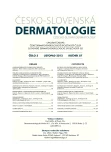Metastatic Melanoma Successfully Treated with Ipilimumab
Authors:
M. Arenbergerová 1; P. Šefrnová 1; E. Pojezná 1; E. Sticová 2; P. Arenberger 1
Authors‘ workplace:
Dermatovenerologická klinika 3. LF UK a FNKV, Praha
přednosta prof. MUDr. Petr Arenberger, DrSc., MBA
1; Ústav patologie 3. LF UK a FNKV Praha
přednosta prof. MUDr. Václav Mandys, CSc.
2
Published in:
Čes-slov Derm, 87, 2012, No. 5, p. 190-193
Category:
Case Reports
Overview
A case study describes a woman with metastatic melanoma. Due to disease progression during dacarbazine therapy ipilimumab – a fully human monoclonal IgG1 antibody selectively binding CTLA antigen – was administered. The complete 12 months lasting remission has been observed in this patient.
Key words:
metastatic malignant melanoma – dacarbazine – ipilimumab – complete remission
Sources
1. FU, T., HE, Q., SHARMA, P. The ICOS/ICOSL Pathway Is Required for Optimal Antitumor Responses Mediated by Anti-CTLA-4 Therapy. Cancer Research, 2011, 71, p. 5445–5454.
2. HAMID, O., SCHMIDT, H., NISSAN, A. et al. A prospective phase II trial exploring the association between tumor microenvironment biomarkers and clinical activity of ipilimumab in advanced Melanoma. Journal of Translational Medicine, 2011, 9, p. 204.
3. HODI, F. S., O’DAY, S. J., MCDERMOTT, D. F. et al. Improved Survival with Ipilimumab in Patients with Metastatic Melanoma. NEJM, 2010, 363, 8, p. 711–723.
4. KLENER, P., ŠŤASTNÝ, M. Posuzování léčebné odpovědi u zhoubných nádorů a potřeba úpravy kritérií pro hodnocení účinnosti imunoterapie. Remedia, 2010, 20, 5, p. 332–336.
5. MAKER, A. V., YANG, J. C., SHERRY, R. M. et al. Intrapatient dose escalation of anti-CTLA-4 antibody in patients with metastatic melanoma. J. Immunother., 2006, 29, 4, p. 455–463.
6. POSTOW, M. A., CALLAHAN, M. K., BARKER, C. A. et al. Immunologic correlates of the abscopal effect in a patient with melanoma. N. Engl. J. Med., 2012, 366, 10, p. 925–931.
7. RIBAS, A., COMIN-ANDUIX, B., ECONOMOU, J. S. et al. Intratumoral immune cell infiltrates, FoxP3, and indoleamine 2,3-dioxygenase in patients with melanoma undergoing CTLA4 blockade. Clinical Cancer Research, 2009, 15, p. 390–399.
8. YUANA, J., ADAMOWA, M., GINSBERGA, B. A. et al. Integrated NY-ESO-1 antibody and CD8+ T-cell responses correlate with clinical benefit in advanced melanoma patients treated with ipilimumab. Proc. Natl. Acad. Sci. USA, 2011, 108, 40, p. 16723–16728.
9. WANG, W., YU, D., SARNAIK, A. A. et al. Biomarkers on melanoma patient T Cells associated with ipilimumab treatment. Journal of Translational Medicine, 2012, 10, p. 146.
10. WEBER, J. S., HAMID, O., CHASALOW, S. D. et al. Ipilimumab increases activated T cells and enhances humoral immunity in patients with advanced melanoma. J. Immunother., 2012, 35, 1, p. 89–97.
11. WOLCHOK, J. D., HOOS, A., O’DAY, S. et al. Guidelines for the evaluation of immune therapy activity in solid tumors: immune-related response criteria. Clin. Cancer Res., 2009, 15, 23, p. 7412–7420.
Labels
Dermatology & STDs Paediatric dermatology & STDsArticle was published in
Czech-Slovak Dermatology

2012 Issue 5
Most read in this issue
- Cutaneous melanoma: Diagnosis, Treatment and Postoperative Follow-up
- Sarcoidosis: a Case with Less Common Clinical Manifestations
- Metastatic Melanoma Successfully Treated with Ipilimumab
- Photodynamic Antiseptic Effect of Photoactive Nanofibers in the Treatment of Leg Ulcers
